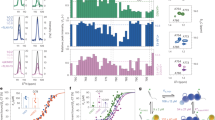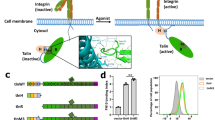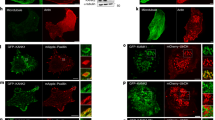Abstract
Transmembrane adhesion receptors, such as integrins, mediate cell adhesion by interacting with intracellular proteins that connect to the cytoskeleton. Talin, one such linker protein, is thought to have two roles: mediating inside-out activation of integrins, and connecting extracellular matrix (ECM)-bound integrins to the cytoskeleton1. Talin's amino-terminal head, which consists of a FERM domain, binds an NPxY motif within the cytoplasmic tail of most integrin β subunits2. This is consistent with the role of FERM domains in recruiting other proteins to the plasma membrane3. We tested the role of the talin-head–NPxY interaction in integrin function in Drosophila. We found that introduction of a mutation that perturbs this binding in vitro2 into the isolated talin head disrupts its recruitment by integrins in vivo. Surprisingly, when engineered into the full-length talin, this mutation did not disrupt talin recruitment by integrins nor its ability to connect integrins to the cytoskeleton. However, it reduced the ability of talin to strengthen integrin adhesion to the ECM, indicating that the function of the talin-head–NPxY interaction is solely to regulate integrin adhesion.
This is a preview of subscription content, access via your institution
Access options
Subscribe to this journal
Receive 12 print issues and online access
$209.00 per year
only $17.42 per issue
Buy this article
- Purchase on Springer Link
- Instant access to full article PDF
Prices may be subject to local taxes which are calculated during checkout




Similar content being viewed by others
References
Nayal, A., Webb, D. J. & Horwitz, A. F. Talin: an emerging focal point of adhesion dynamics. Curr. Opin. Cell Biol. 16, 94–98 (2004).
Garcia-Alvarez, B. et al. Structural determinants of integrin recognition by talin. Mol. Cell 11, 49–58 (2003).
Chishti, A. H. et al. The FERM domain: a unique module involved in the linkage of cytoplasmic proteins to the membrane. Trends Biochem. Sci. 23, 281–282 (1998).
Hynes, R. O. Integrins: bidirectional, allosteric signaling machines. Cell 110, 673–687 (2002).
Bretscher, A., Edwards, K. & Fehon, R. G. ERM proteins and merlin: integrators at the cell cortex. Nature Rev. Mol. Cell Biol. 3, 586–599 (2002).
Becam, I. E., Tanentzapf, G., Lepesant, J. A., Brown, N. H. & Huynh, J. R. Integrin-independent repression of cadherin transcription by talin during axis formation in Drosophila. Nature Cell Biol. 7, 510–516 (2005).
Tadokoro, S. et al. Talin binding to integrin beta tails: a final common step in integrin activation. Science 302, 103–106 (2003).
Martin-Bermudo, M. D., Dunin-Borkowski, O. M. & Brown, N. H. Modulation of integrin activity is vital for morphogenesis. J. Cell Biol. 141, 1073–1081 (1998).
Brown, N. H. et al. Talin is essential for integrin function in Drosophila. Dev. Cell 3, 569–579 (2002).
Du, X. P. et al. Ligands 'activate' integrin αIIbβ3 (platelet GPIIb-IIIa). Cell 65, 409–416 (1991).
Kaapa, A., Peter, K. & Ylanne, J. Effects of mutations in the cytoplasmic domain of integrin β1 to talin binding and cell spreading. Exp. Cell Res. 250, 524–534 (1999).
Calderwood, D. A. et al. The talin head domain binds to integrin β subunit cytoplasmic tails and regulates integrin activation. J. Biol. Chem. 274, 28071–28074 (1999).
Ulmer, T. S., Calderwood, D. A., Ginsberg, M. H. & Campbell, I. D. Domain-specific interactions of talin with the membrane-proximal region of the integrin β3 subunit. Biochemistry 42, 8307–8312 (2003).
Tanentzapf, G., Martin-Bermudo, M. D., Hicks, M. S. & Brown, N. H. Multiple factors contribute to integrin–talin interactions in vivo. J. Cell Sci. 119, 1632−1644 (2006).
Brower, D. L. & Jaffe, S. M. Requirement for integrins during Drosophila wing development. Nature 342, 285–287 (1989).
Yagi, R. et al. A novel muscle LIM-only protein is generated from the paxillin gene locus in Drosophila. EMBO Rep. 2, 814–820 (2001).
Clark, K. A., McGrail, M. & Beckerle, M. C. Analysis of PINCH function in Drosophila demonstrates its requirement in integrin-dependent cellular processes. Development 130, 2611–2621 (2003).
Grabbe, C., Zervas, C. G., Hunter, T., Brown, N. H. & Palmer, R. H. Focal adhesion kinase is not required for integrin function or viability in Drosophila. Development 131, 5795–5805 (2004).
Carman, C. V. & Springer, T. A. Integrin avidity regulation: are changes in affinity and conformation underemphasized? Curr. Opin. Cell Biol. 15, 547–556 (2003).
Prokop, A., Martin-Bermudo, M. D., Bate, M. & Brown, N. H. Absence of PS integrins or laminin A affects extracellular adhesion, but not intracellular assembly, of hemiadherens and neuromuscular junctions in Drosophila embryos. Dev. Biol. 196, 58–76 (1998).
O'Toole, T. E. et al. Integrin cytoplasmic domains mediate inside-out signal transduction. J. Cell Biol. 124, 1047–1059 (1994).
Cluzel, C. et al. The mechanisms and dynamics of αvβ3 integrin clustering in living cells. J. Cell Biol. 171, 383–392 (2005).
Tremuth, L. et al. A fluorescence cell biology approach to map the second integrin-binding site of talin to a 130-amino acid sequence within the rod domain. J. Biol. Chem. 279, 22258–22266 (2004).
Grinblat, Y., Zusman, S., Yee, G., Hynes, R. O. & Kafatos, F. C. Functions of the cytoplasmic domain of the βPS integrin subunit during Drosophila development. Development 120, 91–102 (1994).
Jannuzi, A. L. et al. Disruption of C-terminal cytoplasmic domain of βPS integrin subunit has dominant negative properties in developing Drosophila. Mol. Biol. Cell 13, 1352–1365 (2002).
Chou, T. B. & Perrimon, N. The autosomal FLP-DFS technique for generating germline mosaics in Drosophila melanogaster. Genetics 144, 1673–1679 (1996).
Tepass, U. Crumbs, a component of the apical membrane, is required for zonula adherens formation in primary epithelia of Drosophila. Dev. Biol. 177, 217–225 (1996).
Brower, D. L., Wilcox, M., Piovant, M., Smith, R. J. & Reger, L. A. Related cell-surface antigens expressed with positional specificity in Drosophila imaginal discs. Proc. Natl Acad. Sci. USA 81, 7485–7489 (1984).
Bogaert, T., Brown, N. & Wilcox, M. The Drosophila PS2 antigen is an invertebrate integrin that, like the fibronectin receptor, becomes localized to muscle attachments. Cell 51, 929–940 (1987).
Fogerty, F. J. et al. Tiggrin, a novel Drosophila extracellular matrix protein that functions as a ligand for Drosophila αPS2 βPS integrins. Development 120, 1747–1758 (1994).
Acknowledgements
We are grateful to J. Overton for technical support, and members of the Brown laboratory for critical reading of the manuscript and helpful discussions. This work was supported by a Human Frontiers Scientific Program fellowship to G.T. and Wellcome Trust grant 69943 to N.H.B.
Author information
Authors and Affiliations
Corresponding author
Ethics declarations
Competing interests
The authors declare no competing financial interests.
Supplementary information
Supplementary Information
Supplementary Figures S1 and S2 (PDF 270 kb)
Rights and permissions
About this article
Cite this article
Tanentzapf, G., Brown, N. An interaction between integrin and the talin FERM domain mediates integrin activation but not linkage to the cytoskeleton. Nat Cell Biol 8, 601–606 (2006). https://doi.org/10.1038/ncb1411
Received:
Accepted:
Published:
Issue Date:
DOI: https://doi.org/10.1038/ncb1411
This article is cited by
-
Ihog proteins contribute to integrin-mediated focal adhesions
Science China Life Sciences (2023)
-
Cancer associated talin point mutations disorganise cell adhesion and migration
Scientific Reports (2021)
-
Talin and Kindlin as Integrin-Activating Proteins: Focus on the Heart
Pediatric Cardiology (2019)
-
Mechanical regulation of a molecular clutch defines force transmission and transduction in response to matrix rigidity
Nature Cell Biology (2016)
-
Integration of actin dynamics and cell adhesion by a three-dimensional, mechanosensitive molecular clutch
Nature Cell Biology (2015)



